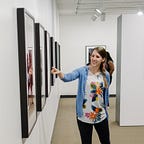What I Learned from my first Museums Advocacy Day
Since joining the museum world, I’ve been hearing about Museums Advocacy Day, but I didn’t really understand what it meant. I figured it was a bunch of high-level museum staff spending the day chatting with office staffers of their representatives about issues that I didn’t fully understand. While I was glad of the work they were doing, it didn’t seem like I could really impact the decisions.
But 2020 began changing my mind about the power of advocacy. I saw how impacted the field was by government decisions, and how they were affecting my colleagues and myself. And I wanted to help.
Additionally, the American Alliance of Museums introduced a program called Social Media Advocates, inviting people to apply to become an advocate to learn about the process and share their experience on social media. It seemed like a great opportunity for me to just dive into the deep end of being an advocate (and have a group of amazing people to be a part of while doing it).
My assumptions and misconceptions
- I won’t know what to say, I won’t be prepared. This is probably the thing I was most concerned about, but it was not an issue at all. As part of the preparations for Museums Advocacy Day, AAM and other local orgs (for me, that meant the Museums Association of New York) had plenty of meetings, databases with resources, clear lists on speaking points, and simple steps on what we needed to say and do in every moment of the event. I independently prepared by reviewing my organization’s impact sheet and comparing our growth and needs against the broader needs of the field so I could come up with some data and stories that were specific to us.
- Why bother when I’m not in a position of power at my organization. I really thought it was going to be mainly senior staff at these meetings, but it actually included a much more diverse group from students who wanted to share their vision for the future to emeritus museum workers who were passionately continuing to voice their support. The representatives appreciated the opportunity to hear from a variety of voices at different levels. Yes, in the bigger meetings, larger museums had more of a voice, but I still felt like I was part of the group calling for action, regardless of my position.
- It’s just going to be a one-way conversation. I went into the meeting thinking that this was going to be us telling the rep what we needed, them politely nodding, and taking notes to share with their Congressperson or Senator. But it was more of a dialogue than I expected. We had issues we wanted their support on, and they have questions and needs from us; they want our support as well. They want to know our perspective on what is happening in the field, and they want us to publicly show our support for the decisions they make.
Other Lessons from Museum Advocacy Day
Your voice, and even your presence, matters. You may not have the opportunity to talk, or may only get to share one short piece of information, but your presence matters. You’re helping support the field by just being there.
Be prepared to speak even if you think you will not get the chance. I honestly thought I was going to be a silent supporter, but under the circumstances, I ended up getting the chance to speak up for my museum. Luckily, I had prepared a little in advance with some stories and data that related specifically to our organization but also touched on the issues we wanted to focus on as a field.
Thank yous are important. I was surprised and delighted to find that one of my thank yous got a direct response from an office member that was actually tailored to my organization. It was exciting to know I was being heard and was able to represent my organization.
What does “attending” involve and what happens on Museums Advocacy Day?
Blaire Moskowitz, one of my fellow AAM Social Media Advocates, wrote a great Reddit post that shares what actually happens leading up to Advocacy Day, and what you do during the two-day experience. I highly suggest reading her post for information on what to expect from the full experience.
For me, it meant:
— One week out: attending a webinar and reading a lot of material about advocacy and what was at stake this year, and attending a call with our state’s museum group to learn our specific goals.
— Monday, February 22: attending a ton of webinars and watching lots of videos reinforcing best practices and sharing the issues at stake, as well as focusing on the priorities of the Biden-Harris administration. It also meant brushing up on my own organization and crafting a couple statements that I could share just in case.
— Tuesday, February 23: attending three meetings with my local and state representatives. The first, was a small meeting where I actually got to speak, and the second and third were very large meetings where I showed support by visibly being active.
Want to attend?
If you’re a first-timer, and have a social media presence, I suggest checking out the Social Media Advocates program by AAM (if they still do it next year). It was a great way to feel like you’re part of an engaged group before you even go into the training and meetings.
